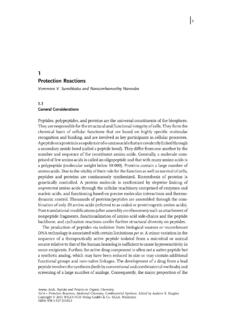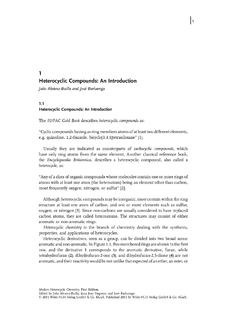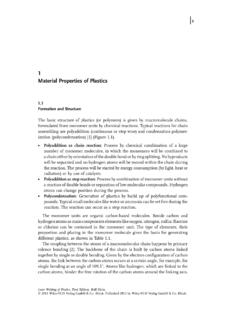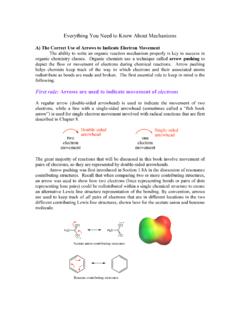Transcription of 1 Basics of Corrosion Chemistry - Wiley-VCH
1 11 Basics of Corrosion ChemistryNorio materials in practical use are normally exposed to Corrosion in theatmospheric and aqueous environments. Metallic Corrosion is one of the problemswe have often encountered in our industrialized society; hence it has been studiedcomprehensively since the industrial revolution in the late eighteenth Corrosion science was set off in the early twentieth century with thelocal cell model proposed by Evans [1] and the Corrosion potential model proved byWagner and Traud [2]. The two models have joined into the modern electrochemicaltheory of Corrosion , which describes metallic Corrosion as a coupled electrochemicalreaction consisting of anodic metal oxidation and cathodic oxidant reduction.
2 Theelectrochemical theory is applicable not only to wet Corrosion of metals at normaltemperature but also to dry oxidation of metals at high temperature [3].Metallic materials corrode in a variety of gaseous and aqueous environments. Inthis chapter, we restrict ourselves to the most common Corrosion of metals in aque-ous solution and in wet air in the atmosphere. In general, metallic Corrosion pro-duces in its initial stage soluble metal ionsin water, and then, the metal ions developinto solid Corrosion precipitates such asmetal oxide and hydroxide. We will discussthe whole process of metallic Corrosion from the basic electrochemical ProcessesThe basic process of metallic Corrosion in aqueous solution consists of the anodicdissolution of metals and the cathodic reduction of oxidants present in the solution:MM M2+aq+2e Manodic oxidation( )Green Corrosion Chemistry and Engineering: Opportunities and Challenges,First by Sanjay K.
3 Sharma. 2012 Wiley-VCH Verlag GmbH & Co. KGaA. Published 2012 by Wiley-VCH Verlag GmbH & Co. Basics of Corrosion Chemistry2 Oxaq+2e M 2 Red(e redox)aqcathodic oxidation( )In the formulae, MMis the metal in the state of metallic bonding, M2+aqis thehydrated metal ion in aqueous solution, e Mis the electron in the metal, Oxaqis anoxidant, Red(e redox)aqis a reductant, and e redoxis the redox electron in the overall Corrosion reaction is then written as follows:MM+2 Oxaq M2+aq+2 Red(e redox)aq( )These reactions are charge-transfer processes that occur across the interfacebetween the metal and the aqueous solution, hence they are dependent on theinterfacial potentialthat essentially corresponds to what is called theelectrodepotentialof metals in electrochemistry terms.
4 In physics terms, the electrodepotential represents the energy level of electrons, called theFermi level,inanelectrode immersed in normal metallic Corrosion , in practice, the cathodic process is carried outby the reduction of hydrogen ions and/orthe reduction of oxygen molecules inaqueous solution. These two cathodic reductions areelectron transferprocesses thatoccur across the metal solution interface, whereas anodic metal dissolution is anion transferprocess across the DiagramThermodynamics shows that an electrode reaction is reversible at its equilibriumpotential, where no net reaction current is observed. We then learn that the anodicreaction of metallic Corrosion may occur only in the potential range more positivethan its equilibrium potential and that the cathodic reaction of oxidant reductionmay occur only in the potential range more negative than its equilibrium , it is known that metallic Corrosion in aqueous solution is dependent notonly on the electrode potential but also onthe acidity and basicity of the solution,that is, the solution thermodynamic prediction of metallic Corrosion was thus illustrated byPourbaix [4]
5 In the form ofpotential pH diagrams, as shown for iron corrosionin Figure The Corrosion of metallic iron may occur in the potential pHregion where hydrated ferrous ions Fe2+, ferric ions Fe3+, and hydroxo-ferrousions Fe(OH) 3are stable. No iron Corrosion occurs in the region where metalliciron is thermodynamically stable at relatively negative electrode potentials. In theregions where solid iron oxides and hydroxides are stable, no iron Corrosion intowater is expected to develop and the iron surface is covered with solid oxidefilms. In the diagram, we also see the equilibrium potentials of the hydrogen andoxygen electrode reactions. Atmospheric oxygen may cause iron Corrosion in thepotential range more negative than the oxygen equilibrium potential,EO2/H2O,while hydrogen ions in aqueous solutionmay carry iron Corrosion in the potentialrange more negative than the hydrogen equilibrium potential,EH+ Metallic 12 1416 2 (OH)3 Fe3O4Fe3+Fe2+EH+/H2 FepHPotential E / VNHEF igure pH diagram for iron Corrosion in water at room the equilibrium potential for the oxygen electrode reaction,EH+/H2 Ois theequilibrium potential for the hydrogen electrode reaction, andVNHEis volt on the normalhydrogen electrode scale [4].
6 We note that the potential pH diagram normally assumes metallic Corrosion inpure water containing no foreign solutes. The presence of foreign solutes in aqueoussolution may affect the Corrosion and anticorrosion regions in the potential pHdiagram. We see in the literature a number of potential pH diagrams for metalliccorrosion in the presence of foreign solutes such as chloride and sulfides [4, 5]. PotentialAn electrode of metal corroding in aqueous solution has an electrode potential,which is called thecorrosion potential. As a matter of course, the Corrosion potentialstands somewhere in the range between the equilibrium potential of the anodicmetal dissolution and that of the cathodic oxidant reduction. It comes from thekinetics of metallic Corrosion that at the Corrosion potential, the anodic oxidationcurrent of the metal dissolution is equal to the cathodic reduction current of theoxidant.
7 The Corrosion kinetics is usually described by the electrode potential versusreaction current curves of both the anodic oxidation and the cathodic reduction,as schematically shown in Figure , which electrochemists call thepolarizationcurvesof Corrosion reactions. We see in Figure that the intersecting point of theanodic and cathodic polarization curves represents the state of Corrosion , namely,the Corrosion potential and the corrosioncurrent. We then realize that the corrosion41 Basics of Corrosion ChemistryicEcorrEciaEaicorriPotential EFigure potential current curves of anodic and cathodic reactions for metal-lic Corrosion ;iais the anodic reaction current,icis the cathodic reaction current,icorris thecorrosion current,Eais the equilibrium potential of the anodic reaction,Ecis the equilib-rium potential of the cathodic reaction, andEcorris the Corrosion is determined by both the anodic and cathodic polarization curves of thecorrosion Corrosion rate of metals may be controlled by either the anodic or thecathodic reaction.
8 In most cases of metallic Corrosion , the cathodic hydrogen ionreduction controls the rate of metallic Corrosion in acidic solution, while in neutralsolution, the cathodic oxygen reduction preferentially controls the Corrosion the Corrosion potential comes out far away from the equilibrium potential of thecathodic reaction, the Corrosion rate willbe controlled by the cathodic reaction. Inpractice, we see that metallic Corrosion is often controlled by the oxygen diffusiontoward the corroding metal surface, in which the Corrosion potential is far morenegative than the oxygen equilibrium Metal DissolutionElectrochemical kinetics gives the reaction current,ia, of anodic metal dissolutionas an exponential function of the electrode potential,E, of the metal as follows:ia=Kaexp( aEkT)( )In Eq.
9 ( ),Kaand aare parameters. The anodic dissolution current of metalliciron, in fact, increases exponentially with the anodic electrode potential in acidsolution as shown in Figure [6].Anodic metal dissolution depends not only on the electrode potential but alsoon the acidity and foreign solutes present in the aqueous solution. It is a Metallic Corrosion5 / H2SO4log |i / 10 2 A cm 2|Potential E / V SCEF igure current curves for corroding iron in sulfuric acid solution at pH 25 C;VSCEis the volt on the saturated calomel electrode scale [6].understanding that the anodic dissolution current of metallic iron depends onthe concentration of hydroxide ions in the solution. Hydrated anions other thanhydroxide ions also have some effects on the anodic metal dissolution.
10 Hydratedhydroxide ions are found to acceleratethe anodic iron dissolution in weeklyacidic solution; whereas they decelerate(hydrated hydrogen ions accelerate) theiron dissolution in strongly acidic solution [7]. Furthermore, in acidic solution,hydrated chloride ions accelerate the anodic iron dissolution in relatively con-centrated chloride solution, while they inhibit the iron dissolution in relativelydilute chloride solution [7]. These factssuggest that anions of different sorts com-pete with one another in participating in the process of anodic metal dissolutionprobably through their adsorption on the metal surface forming activated inter-mediates, such as FeOH+adand FeCl+ad, which will determine the metal dissolutionrate [7].










